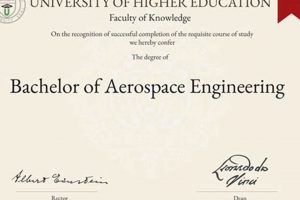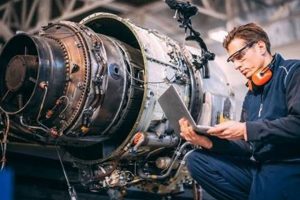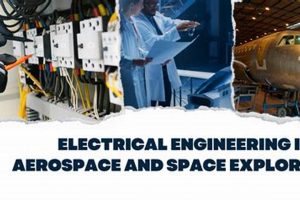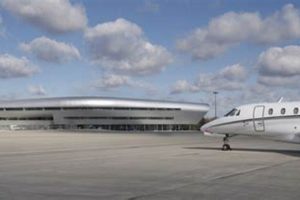The field that encompasses the design, development, testing, and production of aircraft, spacecraft, and related systems is a technologically advanced discipline. It addresses challenges related to flight within and beyond Earth’s atmosphere, focusing on aerodynamic principles, propulsion systems, materials science, and control mechanisms. For example, the creation of a new generation of fuel-efficient commercial airliners and the development of advanced satellite communication systems are direct outcomes of this area of study.
Its significance lies in its contribution to advancements in transportation, communication, defense, and scientific exploration. Innovations arising from this sector have profound impacts on global economies, national security, and our understanding of the universe. Historically, progress in this area has spurred economic growth, facilitated international collaboration, and pushed the boundaries of human achievement.
Therefore, understanding the fundamental principles, diverse applications, and future directions within this field is paramount. Subsequent discussions will delve into specific areas of interest, including the challenges of sustainable air travel, the exploration of space, and the ethical considerations surrounding technological advancements in this critical domain.
The following points offer direction for individuals pursuing or engaging with aerospace engineering, emphasizing rigorous methodology and critical thinking.
Tip 1: Cultivate a Strong Foundation in Mathematics and Physics: Mastery of calculus, differential equations, linear algebra, and fundamental physics principles is indispensable. Aerospace engineering relies heavily on these disciplines for modeling and analysis.
Tip 2: Develop Proficiency in Computational Tools: Familiarity with software used for modeling, simulation, and data analysis is crucial. Examples include MATLAB, ANSYS, and computational fluid dynamics (CFD) software.
Tip 3: Emphasize Systems Thinking: Aerospace projects are complex and involve numerous interacting components. Understanding how individual elements contribute to the overall system performance is essential for effective design and problem-solving.
Tip 4: Acquire Practical Experience Through Internships and Projects: Applying theoretical knowledge to real-world problems is invaluable. Internships with aerospace companies or participation in relevant research projects provide hands-on experience.
Tip 5: Stay Abreast of Technological Advancements: The aerospace field is constantly evolving. Maintaining awareness of emerging technologies, such as additive manufacturing, advanced materials, and autonomous systems, is crucial for remaining competitive.
Tip 6: Hone Communication and Collaboration Skills: Aerospace projects often involve multidisciplinary teams. Effective communication, teamwork, and the ability to present technical information clearly are highly valued.
Tip 7: Focus on Problem-Solving and Critical Analysis: The ability to identify problems, analyze them rigorously, and develop innovative solutions is a hallmark of successful aerospace engineers.
By adhering to these guidelines, individuals can enhance their prospects for success within aerospace engineering, contributing to advancements in flight, space exploration, and related technologies.
The subsequent sections will offer a more detailed exploration of specialized areas within the field and the challenges and opportunities that they present.
1. Innovation
Innovation is a central impetus behind the ongoing development within aerospace engineering. It fuels the continuous quest for improved performance, efficiency, and capability in both aeronautical and astronautical systems. The field’s reliance on cutting-edge technology and its inherent drive to overcome physical limitations create a fertile ground for innovative solutions.
- Advanced Materials Development
The creation of lighter, stronger, and more heat-resistant materials is fundamental to aerospace engineering. Innovations in composites, alloys, and nanomaterials enable the design of more efficient aircraft and spacecraft, improving fuel consumption, payload capacity, and structural integrity. For example, the development of carbon fiber reinforced polymers has revolutionized aircraft design, leading to lighter and more fuel-efficient airframes.
- Propulsion System Advancements
Significant innovation is focused on enhancing propulsion systems. This includes the development of more efficient jet engines, ramjets, scramjets, and electric propulsion systems. Advancements in these areas allow for higher speeds, longer ranges, and reduced emissions. For instance, the development of variable cycle engines seeks to optimize engine performance across a wide range of flight conditions, improving efficiency and versatility.
- Autonomy and Control Systems
The integration of autonomous systems and advanced control algorithms is transforming aerospace engineering. Innovations in artificial intelligence, machine learning, and sensor technology enable the development of unmanned aerial vehicles (UAVs), autonomous spacecraft, and advanced flight control systems. These advancements enhance mission capabilities, reduce pilot workload, and improve safety. For example, autonomous landing systems for aircraft are becoming increasingly sophisticated, enhancing safety in adverse weather conditions.
- Aerodynamic Design Optimization
Continuous refinement of aerodynamic designs is essential for improving aircraft performance. Innovations in computational fluid dynamics (CFD), wind tunnel testing, and experimental aerodynamics allow engineers to optimize wing shapes, control surfaces, and overall aircraft configurations. These optimizations lead to reduced drag, increased lift, and improved fuel efficiency. For instance, the development of winglets and blended wing bodies are examples of aerodynamic innovations that improve aircraft performance.
These innovations are not merely incremental improvements, but often represent paradigm shifts that redefine the possibilities within aerospace engineering. The pursuit of innovation remains a primary driver, shaping the future of flight and space exploration and solidifying the rationale behind why individuals and organizations dedicate resources to this dynamic field.
2. Exploration
Exploration serves as a core motivator within aerospace engineering, driving the field to transcend terrestrial boundaries and venture into the unknown. This inherent desire to explore fosters innovation and provides justification for the significant resources invested in aerospace endeavors.
- Space Exploration Missions
The design, development, and execution of space exploration missions are central to aerospace engineering. These missions, ranging from orbiting satellites to interplanetary probes, require advanced engineering solutions to overcome the challenges of space travel. Examples include the Mars rovers, Voyager probes, and the James Webb Space Telescope. The success of these missions hinges on precise control systems, robust communication technologies, and reliable propulsion systems, all of which necessitate continuous innovation in aerospace engineering.
- Extraterrestrial Resource Utilization
The potential for utilizing resources found on other celestial bodies, such as the Moon and Mars, presents a significant area of focus for aerospace engineers. Developing technologies for extracting, processing, and utilizing these resources requires novel engineering approaches. This includes designing robotic systems for mining, processing facilities for refining materials, and propulsion systems for transporting resources. The prospect of extraterrestrial resource utilization fuels research into advanced materials, autonomous systems, and sustainable energy solutions.
- Human Spaceflight and Habitability
Ensuring the safety and well-being of humans in space is a paramount concern for aerospace engineering. Designing spacecraft and habitats capable of supporting human life in the harsh environment of space requires meticulous attention to detail and innovative solutions. This includes developing life support systems, radiation shielding, and exercise equipment to mitigate the physiological effects of prolonged spaceflight. The goal of expanding human presence beyond Earth drives research into closed-loop life support systems, advanced propulsion technologies, and innovative habitat designs.
- Remote Sensing and Earth Observation
Aerospace engineering enables the development of satellites and aircraft equipped with sensors for observing Earth. These remote sensing systems provide valuable data for a wide range of applications, including weather forecasting, climate monitoring, and natural resource management. Designing and deploying these systems requires expertise in sensor technology, signal processing, and orbital mechanics. The increasing demand for Earth observation data drives innovation in satellite technology, data processing algorithms, and remote sensing applications.
These facets of exploration underscore the crucial role of aerospace engineering in expanding the boundaries of human knowledge and capability. The challenges inherent in these endeavors serve as a catalyst for technological advancement, reinforcing the importance of the field and driving continued investment in its development.
3. Advancement
Advancement constitutes a fundamental pillar supporting the rationale behind aerospace engineering. The field’s perpetual pursuit of progress acts as both a cause and an effect. Aerospace engineering drives technological and scientific advancement, and, conversely, the desire for advancement fuels continued investment and innovation within the discipline. This symbiotic relationship underscores the practical significance of the field. For example, the development of more efficient jet engines directly stems from the goal of achieving greater fuel economy and reduced emissions, while simultaneously enabling longer-range flights and increased operational efficiency.
The importance of advancement within aerospace engineering is further exemplified by the ongoing research into hypersonic flight. This endeavor aims to revolutionize air travel by enabling significantly faster transit times. The complexities associated with hypersonic flight, including managing extreme heat and maintaining stability at high speeds, necessitate breakthroughs in materials science, aerodynamics, and propulsion systems. Success in this area would not only transform air travel but also have implications for space access and national defense. Another illustration is the improvement of satellite technology and its effect of creating efficient communication system.
In conclusion, the interconnection between advancement and aerospace engineering is undeniable. The pursuit of progress in this domain leads to tangible benefits across numerous sectors, ranging from transportation and communication to scientific exploration and national security. While challenges remain in pushing the boundaries of what is achievable, the unwavering commitment to advancement ensures that aerospace engineering will continue to be a driving force in shaping the future of technology and exploration. The goal to advancement keeps aerospace engineering relevant in today’s modern and fast changing world.
4. Challenges
Aerospace engineering inherently confronts significant challenges that serve as a primary driver for innovation and research. These obstacles necessitate creative problem-solving and push the boundaries of current technological capabilities. The complexity and rigor involved in addressing these challenges are central to understanding the motivations behind dedicating resources to this field.
- Extreme Environmental Conditions
Aerospace systems operate in extreme environments characterized by high and low temperatures, radiation exposure, and vacuum conditions. Designing materials and components that can withstand these conditions requires extensive research and advanced engineering techniques. For example, spacecraft deployed in deep space must endure extreme temperature fluctuations and radiation exposure that can degrade materials and electronic components. Mitigating these effects drives the development of specialized coatings, radiation-hardened electronics, and thermal management systems. The need to overcome these environmental challenges is a crucial factor in justifying the investment in aerospace engineering.
- Aerodynamic Complexity at High Speeds
Designing aircraft and spacecraft that can operate efficiently and safely at high speeds presents significant aerodynamic challenges. Phenomena such as shock waves, turbulence, and aerodynamic heating become increasingly pronounced at supersonic and hypersonic speeds. Overcoming these challenges requires advanced computational fluid dynamics simulations, wind tunnel testing, and innovative aerodynamic designs. For instance, the development of hypersonic vehicles necessitates the design of airframes that can withstand extreme heat loads and maintain stability at high speeds. The complexity of these aerodynamic challenges fuels ongoing research in areas such as boundary layer control, shock wave mitigation, and high-temperature materials.
- Propulsion System Efficiency and Reliability
Developing propulsion systems that are both efficient and reliable is critical for aerospace applications. Propulsion systems must generate sufficient thrust to overcome drag and lift vehicles into the air or into space. They must also operate reliably under a wide range of conditions. The quest for improved propulsion system performance drives research into advanced engine designs, fuel technologies, and combustion processes. For example, the development of more efficient jet engines and rocket engines is essential for reducing fuel consumption and increasing payload capacity. The challenges associated with achieving high efficiency and reliability in propulsion systems are a key driver of innovation in aerospace engineering.
- System Integration and Complexity
Aerospace systems are highly complex, involving numerous interacting components and subsystems. Integrating these components into a functional and reliable system requires careful planning, coordination, and testing. The complexity of these systems increases the risk of failures and necessitates robust fault detection and mitigation strategies. For example, integrating avionics, flight control systems, and communication systems in an aircraft requires meticulous attention to detail and rigorous testing to ensure that all components work together seamlessly. The challenges associated with system integration and complexity necessitate the development of advanced modeling and simulation tools, as well as rigorous testing and validation procedures.
These challenges collectively underscore the critical role of aerospace engineering in pushing the boundaries of technological capability. Overcoming these obstacles requires a multidisciplinary approach, drawing on expertise from diverse fields such as materials science, fluid dynamics, and control systems. The ongoing pursuit of solutions to these challenges serves as a primary impetus for continued investment and innovation in aerospace engineering.
5. Solutions
The provision of solutions to complex problems constitutes a central reason for the existence and continued development of aerospace engineering. The discipline is fundamentally solution-oriented, addressing challenges inherent in flight, space exploration, and related technological domains. The effectiveness and ingenuity of these solutions directly impact the safety, efficiency, and feasibility of aerospace endeavors. For instance, the development of active flow control systems provides solutions to aerodynamic instability, improving aircraft performance and safety. Similarly, advancements in satellite propulsion systems offer solutions for maintaining orbital position and extending mission lifespans.
The solutions derived from aerospace engineering often have broader applications beyond the immediate field. Technologies developed for aerospace applications frequently find use in other sectors, such as medicine, transportation, and energy. For example, composite materials initially developed for aircraft structures are now widely used in medical implants and automotive components. Furthermore, the computational modeling techniques used in aircraft design have been adapted for applications in weather forecasting and financial modeling. This cross-sector impact highlights the practical significance of aerospace engineering’s problem-solving capabilities.
In summary, the emphasis on generating effective solutions is a defining characteristic of aerospace engineering and a primary justification for its importance. The ability to address complex challenges related to flight and space exploration not only advances the field itself but also generates solutions that benefit broader society. The continuous pursuit of innovative solutions ensures that aerospace engineering remains a vital and relevant discipline, driving progress in technology and expanding the scope of human endeavors.
6. Progress
The symbiotic relationship between progress and aerospace engineering underscores the field’s fundamental importance. Aerospace engineering inherently drives technological and scientific advancement, and conversely, the ambition for progress fuels continued investment and innovation within the discipline. This cyclical dynamic is a critical component of understanding the field’s enduring relevance. For example, the evolution of jet engine technology from early, inefficient designs to modern, high-bypass turbofans exemplifies how progress in aerospace engineering has directly led to improved fuel efficiency, reduced emissions, and enhanced aircraft performance. This progress, in turn, stimulates further research and development aimed at achieving even greater levels of efficiency and sustainability.
Another illustration of this connection is the development of reusable spacecraft. The Space Shuttle program, while facing its own challenges, represented a significant step towards reducing the cost of space access. The subsequent development of commercially viable reusable launch systems, such as those pioneered by SpaceX, demonstrates the continuous pursuit of progress in this area. These advancements not only make space exploration more accessible but also create opportunities for new industries and scientific discoveries. The improvements in satellite technology, driven by the demand for better communication and remote sensing capabilities, provide another clear example of how progress within aerospace engineering translates into tangible benefits for society.
In conclusion, the unwavering commitment to progress is a defining characteristic of aerospace engineering. The ongoing pursuit of more efficient, sustainable, and capable systems ensures that the field will continue to be a driving force in shaping the future of technology and exploration. While challenges undoubtedly remain in pushing the boundaries of what is achievable, the inherent drive for progress guarantees that aerospace engineering will remain a vital and relevant discipline for decades to come. It is the continual advancement that makes the field worth understanding and investing in.
7. Discovery
The relationship between discovery and aerospace engineering is fundamentally intertwined. Aerospace engineering, in its pursuit of novel solutions and technologies, relies heavily on the process of discovery. This process encompasses both the identification of new scientific principles and the innovative application of existing knowledge. The drive for discovery is therefore an integral component in understanding the rationale behind the field. For instance, the discovery of new materials with superior strength-to-weight ratios directly enables the construction of more efficient and capable aircraft and spacecraft. This, in turn, facilitates further exploration and scientific investigation.
Practical applications of this dynamic are readily apparent. The development of advanced propulsion systems, such as ion thrusters or scramjets, hinges on fundamental discoveries in physics and engineering. The analysis of data gathered by space-based telescopes relies on sophisticated algorithms and computational techniques, often requiring new mathematical or statistical methods. Furthermore, the design of life support systems for long-duration space missions necessitates a deep understanding of human physiology and the creation of innovative solutions for resource management and waste recycling. These are concrete examples of the field pushing at the frontier of scientific discovery.
In conclusion, discovery is not merely a byproduct of aerospace engineering but rather a critical and enabling factor. The inherent complexities and challenges associated with flight and space exploration demand continuous innovation, which, in turn, fuels scientific discovery. This reciprocal relationship solidifies the field’s significance, ensuring that aerospace engineering remains a vital driver of technological progress and human knowledge. The practical impact of these discoveries is evident across numerous sectors, highlighting the field’s enduring value and justifying continued investment in its development.
Frequently Asked Questions
The following section addresses common inquiries regarding the nature, scope, and significance of aerospace engineering. The responses provided are intended to offer clarity and insight into this complex and evolving field.
Question 1: What are the core disciplines encompassed by aerospace engineering?
Aerospace engineering fundamentally integrates aeronautical engineering, which focuses on flight within Earth’s atmosphere, and astronautical engineering, which addresses flight beyond Earth’s atmosphere. Key disciplines include aerodynamics, propulsion, structural analysis, control systems, and materials science.
Question 2: What are the primary applications of aerospace engineering?
Applications are diverse and span commercial aviation, defense systems, space exploration, satellite technology, and related fields. This includes the design and development of aircraft, spacecraft, missiles, satellites, and associated systems and equipment.
Question 3: What role does computational modeling play in aerospace engineering?
Computational modeling is a crucial tool for simulating and analyzing complex aerospace systems. Computational fluid dynamics (CFD) is used to predict aerodynamic performance, finite element analysis (FEA) assesses structural integrity, and system simulations model overall system behavior.
Question 4: How does aerospace engineering contribute to sustainability?
Aerospace engineering contributes to sustainability through the development of more fuel-efficient aircraft, alternative propulsion systems (e.g., electric and hybrid-electric propulsion), and advanced materials that reduce weight and improve performance. Research into sustainable aviation fuels and optimized flight paths also plays a significant role.
Question 5: What are the career prospects for aerospace engineers?
Career opportunities for aerospace engineers are generally favorable, with demand driven by the ongoing need for innovation in aviation, space exploration, and defense. Potential career paths include design engineering, research and development, testing and analysis, project management, and consulting.
Question 6: What are some of the emerging trends in aerospace engineering?
Emerging trends include the development of autonomous aircraft and spacecraft, the increasing use of additive manufacturing (3D printing) for aerospace components, the exploration of hypersonic flight, and the growth of the commercial space industry. These trends are driving innovation and creating new opportunities for aerospace engineers.
In summary, aerospace engineering is a multifaceted discipline with significant implications for technology, exploration, and society. Its contributions extend beyond the development of aircraft and spacecraft, influencing advancements in various related fields.
The following sections will provide a more in-depth exploration of the skills and knowledge required to succeed in aerospace engineering.
Conclusion
This exploration of why aerospace engineering holds significance reveals a field driven by innovation, exploration, advancement, and a relentless pursuit of solutions to complex challenges. The interconnected nature of these drivers underscores the discipline’s critical role in shaping technological progress and expanding human understanding of the universe. Its contributions extend far beyond the design and construction of aircraft and spacecraft, influencing advancements in materials science, propulsion systems, and computational modeling with impacts across diverse sectors.
As humanity faces emerging challenges in transportation, sustainability, and exploration, the expertise and ingenuity of aerospace engineers will be paramount. Continued investment in research, development, and education within this field is essential to unlock future breakthroughs and ensure that aerospace engineering remains a driving force for progress in the decades to come. The future of flight and space exploration relies on the continued commitment to addressing the complex questions and challenges that aerospace engineering endeavors to solve.







